Comments/Ratings for a Single Item
I do plan to eventually reduce the number of images, and with that in mind, I suppose using comments has the advantage of keeping the images around for reference even if I do decide against some of them later. So first I'll post the new images here for reference, and then I will remove some from the page:
For a more compact piece that would work well with Staunton pieces, it helps to move away from a literal representation of a centaur and instead portray the bust of someone with both horse and human features. In a literal sense, this might be a reverse centaur or a were-horse, but at least it gets across the idea of a centaur better than a more human-like bust of a centaur would. Here are a few pieces generated with this kind of depiction:
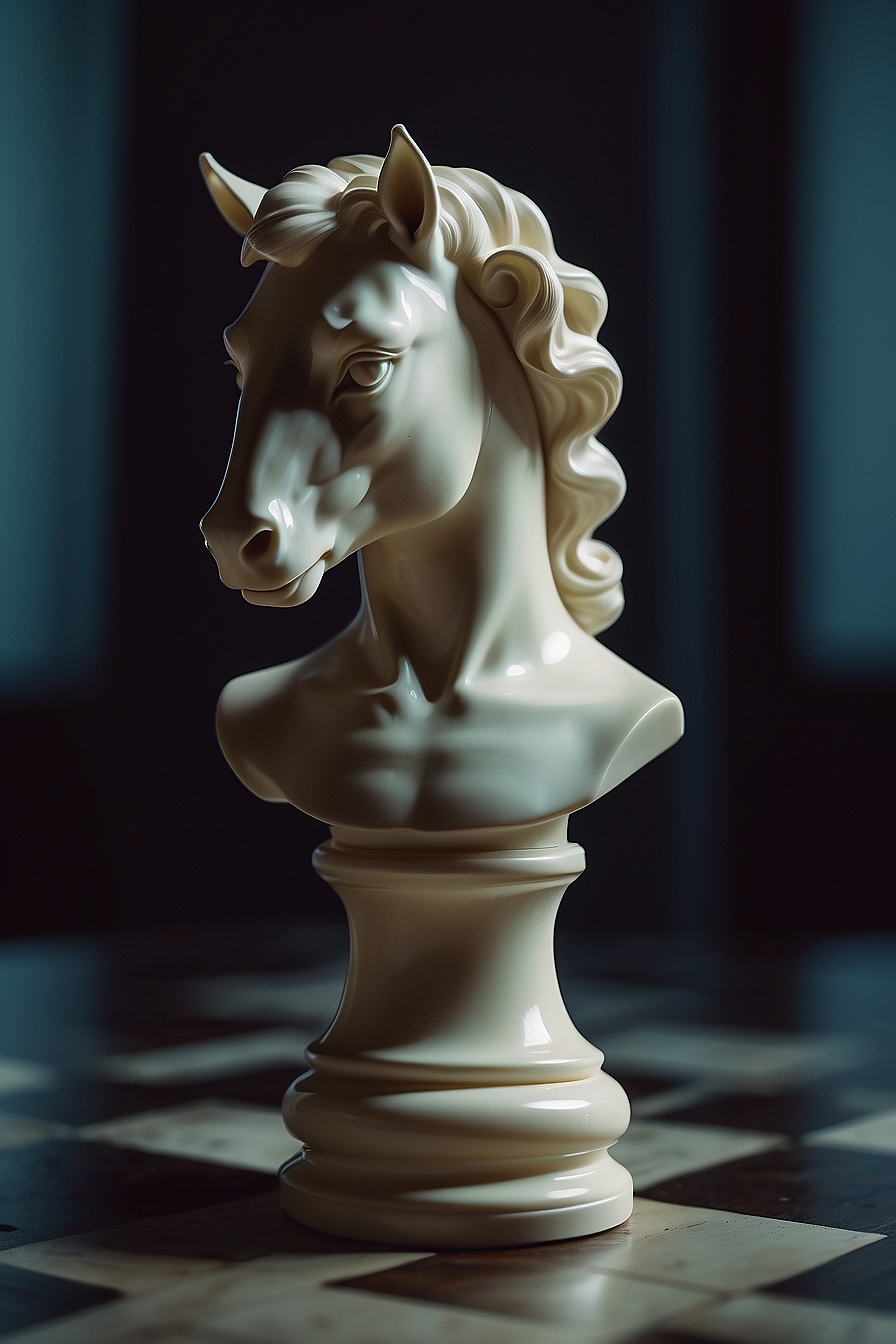


.jpg)

.jpg)
Along a similar vein, we may have a horse wearing a helmet.
.jpg)
.jpg)
Or taking inspiration from the knight in Lewis Carroll's Through the Looking-Glass, we could use a knight in a horse-shaped helmet.
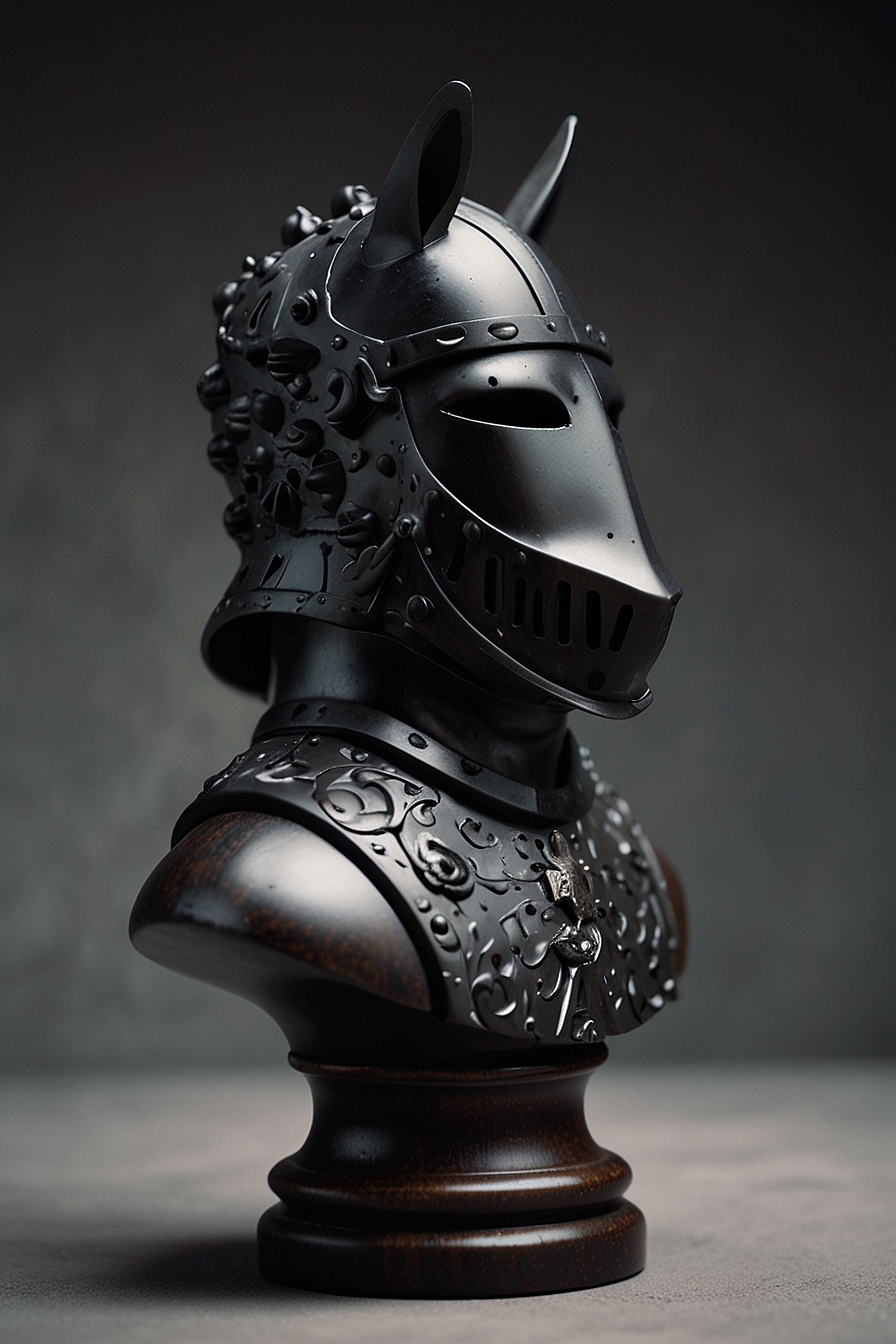
.jpg)
.jpg)
Snark or not, I agree with H.G. that this is entirely too much art for a piececlopedia page. If you wanted to get feedback on the various outputs you've generated (to decide on one or two for the page), that should've been done in comments.
I have to agree here, at least in principle. No more than three or four AI illos should be present on a Piececlopedia page, and even that many only when there are that many different versions to help with people's inventiveness (or that many different representations of the piece, as is the case with he Carpenter / Templar / Doughnut / Yar*). In this case, I'd suggest keeping the full-figure centaur and the two that I pointed out.
Even so, I wouldn't object to "Art Gallery" pages being a part of this site, similar to the Craft and Photo pages.
*The Yar is out of my Tifinagh set, and so technically counts as my own invention, though it does have the same move pattern as the other three and so counts for these purposes.
At present, each image represents a different idea or a different enough variation on the same idea.
@Kevin: "Such a piece could become royal simply by adding a cross on top, if desired, as Jean-Louis did with an earlier image he gave (except that in that one, the base was not as tall as for a Staunton chess K, if I recall right). edit: another possibility is to use the base of the Man, up to the neck, from the picture in the Piececlopedia entry for a Man, and put a horse's head on it."
If you look at my recent page, the reason why I've made the base of the "Knight with cross" smaller is to avoid the confusion with the Amazon.
Also, putting a horse's head on a Man's base is just the opposite of a centaur, as said by others in the comments. It keeps the idea of mixing horse and man, but on a different order.
In this discussion, my opinion is that a certain level of abstraction is possible, if not desirable, with Staunton style. I imagine if the challenge was to design a Bishop, I guess not many, human or AI, would come to what is a Staunton Bishop today.
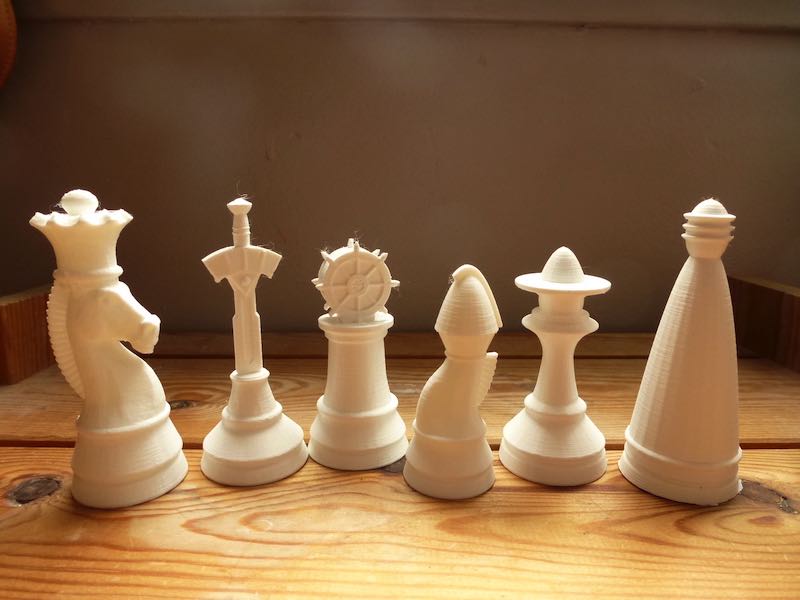
 H. G. Muller wrote on Mon, Apr 1 05:23 AM EDT in reply to Jean-Louis Cazaux from 02:25 AM:
H. G. Muller wrote on Mon, Apr 1 05:23 AM EDT in reply to Jean-Louis Cazaux from 02:25 AM:If the idea is to represent the move, the logical form in a set where the Amazon is a Staunton Knight with the head of a Staunton Queen mounted on top of it, would be a King's head on a Knight. The cross could be omitted for the non-royal case.
If the idea is to represent an actual centaur, rather than just an arbitrary man-horse chimera, the Staunton style seems to lead to something like this:
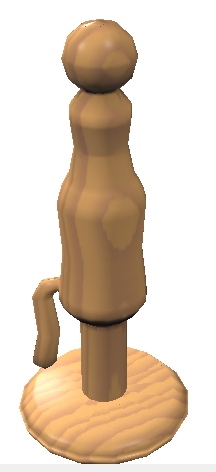
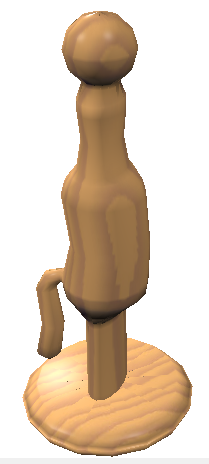

That is, omit all upper extremities, and only leave a stylized version of the lowest for support. The one in the middle already breaks Staunton style by abandoning cylindrical symmetry (ellipticity is used in the hind legs and torso, and excentricity in the horse body).
The tail is in fact already dubiously detailed; if the cut in the Bishop's head was deemed enough to represent tusks, the tail should probably be represented by an upward diagonal cut just above the legs...
Of course it would be quite possible to apply further symmetry breaking (rightmost image) to get still further away from Staunton abstraction and closer to realism: the hind legs and torso could be slanted backwards, the horse's body forwards. An indication for the horse's front leges could be added, dangling down like it is prancing.
@HG: your post is inspiring. I'll see if I can come to something.
Re: "If the idea is to represent the move, the logical form in a set where the Amazon is a Staunton Knight with the head of a Staunton Queen mounted on top of it, would be a King's head on a Knight. The cross could be omitted for the non-royal case."
I'd trusted that Fergus had already thought of that and hadn't found a way to make it work, for some reason. It'll be interesting to see if anyone else can, as it would avoid using a 'reverse centaur' figurine. Maybe a Man's head (from Piececlopedia page for that) on top of a knight could be even better.
As this page is under the light, I have several comments. We have a header saying: "The Piececlopedia is intended as a scholarly reference concerning the history". Indeed, the first section is Historical Notes. But, there is almost no history at all in this section, and no scholarship. The minimum would be to give dates of invention to put the information in a historical perspective.
- Courier-Spiel by Albers, 1821: (Councellor)
- Renniassance Chess by Eric V. Greenwood, 1980 (Page)
- Royal Court by Sidney LeVasseur, 1998 (Crowned Knight)
- Cobra Chess by Derick Peterson, 1998 (Duke)
- Jupiter by Adrian King, 1999 (Centaur)
- Fantasy Grand Chess by Peter Hatch, 2000 (Wolf Rider)
- Kung Fu Chess by Tim Bostick, 2001 (Tiger)
Then, why 4 lines talking only about Fergus Duniho's variants? Why these variants would deserve more attention than the other ones?
There are other variants which are using a KN compound. For example Cataclysm (Greg Strong, 2007), Reformed Courier-Spiel (Clément Begnis, 2011, as a Paladin), Sac Chess (Kevin Pacey, 2014, as a Judge). I'll be silent about my own variants.
Second, like HG I think it is not necessary to have a section about "AI Art" here. It completly modify the purpose of this page. @Fergus, I would suggest you write a separate page where you show your drawings made with AI as I have done myself with my 3D-printable creations. Having 1 illustration is one thing, but I do think it is not good that you place your own things in pages which are of general attention. There is some confusion here.
@Kevin: this is in the case "where the idea is to represent the move". It is feasible to do this, I have made some attempts, but practically if you play SAC chess for example, it is not nice to have so many "knights" on board, the regular ones, those topped by a Rook, those by a Bishop's head, those by a King's head, those by a Queen's crown. Moreover, KN, QN and RN are too much similar-looking I can tell. Of course, those in love with horses will be delighted :=)
A general problem with fairy chess piece figurines is that while the 6 types of Staunton chess figurines are all quite distinct and serve orthodox chess well, for chess variants sometimes in a given CV such as Sac Chess there can a lot of similar-looking types, it may be unavoidable in such a case. Similar issues might happen for other CVs too, even if the practical similarity issue went away for just that particular CV (i.e. Sac Chess). Fergus' main concern is to get a good-looking Staunton-style figurine of a Centaur that can be used both on the Piececlopedia page and seemingly for a lot of CV games, the latter being difficult to imagine in the form of an example collection of them.
Perhaps a Knight figurine with a Man's head at the top would be the best thought for a Staunton-style Centaur figurine, if the Centaur were not a royal version.
@HG: I have just taken the Bishop's base to have a better Stauntob-look. This is very rough, very very. I could change many things, adjust shapes, soften, etc. but on the overall, what about this very stylised form?

If the idea is to represent the move, the logical form in a set where the Amazon is a Staunton Knight with the head of a Staunton Queen mounted on top of it, would be a King's head on a Knight. The cross could be omitted for the non-royal case.
I'd trusted that Fergus had already thought of that and hadn't found a way to make it work, for some reason
I hadn't thought of it, because a crossless crown is still a crown. Having thought about it now, the cross is the main thing distinguishing the king's crown from the queen's. So, a knight with a crossless crown could easily be confused with an amazon. My thought has been to combine man and horse in some way.
It'll be interesting to see if anyone else can, as it would avoid using a 'reverse centaur' figurine. Maybe a Man's head (from Piececlopedia page for that) on top of a knight could be even better.
As crowns and miters are something worn on the head, some other kind of headgear, such as a helmet or a hat would probably be suitable for a piece with the additional powers of a man. While this might not work as easily for rook+man or bishop+man, these are also rook+ferz and bishop+wazir and are known by other names, such as dragon horse and dragon king. So maybe they could be represented in a different manner. Or all three might be represented by human face pieces like in the Superba set.
I'm actually a little annoyed that I didn't think of doing it this way myself. I'd go with something like the third image, personally, and also add something to indicate arms.
Now that I think on it, I might just give it a go.
"I hadn't thought of it, because a crossless crown is still a crown. Having thought about it now, the cross is the main thing distinguishing the king's crown from the queen's. So, a knight with a crossless crown could easily be confused with an amazon."
I agree. It is what I said too in this thread.
@Bob: "I'd go with something like the third image, personally, and also add something to indicate arms". I think it can be investigated with the S shape if the front of the S is going further than where the straight trunk is connected. Also the rear of the S may let think of the tail. Perhaps, the S needs to be flattened, less vertical and more horizontal. To be tried.
 H. G. Muller wrote on Mon, Apr 1 11:13 AM EDT in reply to Jean-Louis Cazaux from 10:58 AM:
H. G. Muller wrote on Mon, Apr 1 11:13 AM EDT in reply to Jean-Louis Cazaux from 10:58 AM:The S seems to curve in the wrong direction. A prancing horse doesn't bend his back in that direction. E.g. the Ferrari logo:
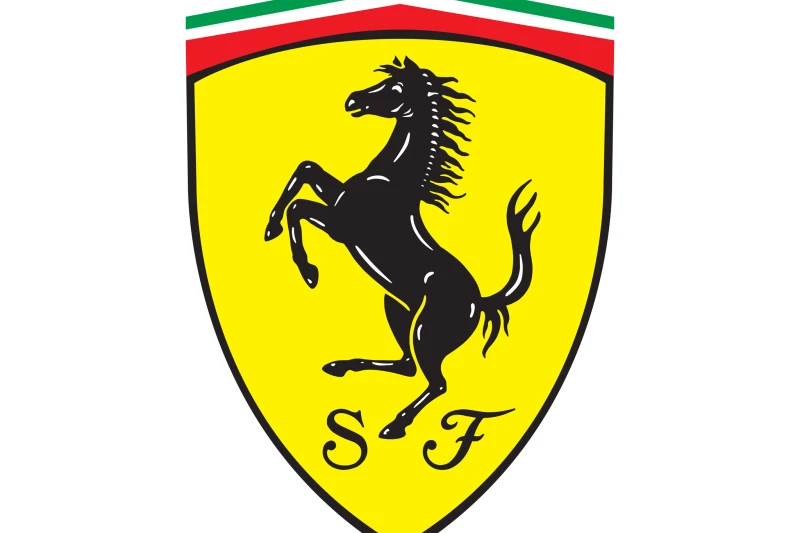
 H. G. Muller wrote on Mon, Apr 1 11:32 AM EDT in reply to Fergus Duniho from 10:35 AM:
H. G. Muller wrote on Mon, Apr 1 11:32 AM EDT in reply to Fergus Duniho from 10:35 AM:As crowns and miters are something worn on the head, some other kind of headgear, such as a helmet or a hat would probably be suitable for a piece with the additional powers of a man. While this might not work as easily for rook+man or bishop+man, these are also rook+ferz and bishop+wazir and are known by other names, such as dragon horse and dragon king. So maybe they could be represented in a different manner. Or all three might be represented by human face pieces like in the Superba set.
Even though chess pieces (unlike the pictograms used in 2d diagrams) are more than just the head or head cover, it is true that the head is the distinctive feature, and the bodies all look alike.
To indicate the KN move in a variant that also features the Amazon, you could leave on the cross. It is very unlikely there will be both a royal and non-royal Centaur in the same variant. Or replace the cross by a spike, to distinguish it both from a Queen and a King head.
The Jocly 3d pieces can provide some inspiration; the Crowned Rook there is a Rook with a crossless King head mounted on top. No room for confusion there; a Rook with a Queen's head would make no sense. For the Crowned Bishop I use a pontifical tiara. Both give pieces that distinguish themselves very well from other Staunton pieces.
The minimum would be to give dates of invention to put the information in a historical perspective.
I copied your list to the page and made the URLs relative. If you want to expand that list or add more content to the page, you can post it here.
For representing this piece, why not do something similar to this?
In 3D it could be a regular knight except with an eight pointed collar or base to indicate the extra moves.
Either that, or use a spikey style hairdo on the knight, like a punk-look. :)
 H. G. Muller wrote on Tue, Apr 2 02:44 PM EDT in reply to Daniel Zacharias from 02:22 PM:
H. G. Muller wrote on Tue, Apr 2 02:44 PM EDT in reply to Daniel Zacharias from 02:22 PM:That is how I represented the ferz-knight and wazir-knight in Jocly (e.g. in Scirocco): A Knight on a somewhat taller base (so it is not so easily confused with a normal Knight) in the shape of a cross, oriented along the F or W move.
As far as I'm concerned, I want to avoid using a knight at all. I want a centaur. A centaur doesn't have a horse's head. By definition.
Maybe for Kevin there is another solution: as for you it's a judge, maybe it's easier to find a representation.
 H. G. Muller wrote on Tue, Apr 2 02:59 PM EDT in reply to Jean-Louis Cazaux from 02:47 PM:
H. G. Muller wrote on Tue, Apr 2 02:59 PM EDT in reply to Jean-Louis Cazaux from 02:47 PM:Well, the knight-on-a-shaped-base is a move-oriented solution, so it ignores the name entirely.
I'm not sure a reverse centaur isn't considered a type of centaur by at least some people, but yes, it isn't the archetype. Still, the guard symbol on top of the knight figurine is what was decided on for Alfaerie 2D figurines, at least, as Daniel is alluding to.
Calling a Centaur piece type a Judge was something I did when somehow I thought I saw no entry for NWF in wikipedia the first time I looked at a fairy pieces wiki (maybe edited since, or I missed it), before I applied to and looked at CVP site. A 3D figurine for a judge-person may be easier to imagine and create, who knows. On the bright side, there are nothing but real people (or rook) represented among Sac Chess pieces, i.e. nothing mythical used for CV warfare in my CV's case.
25 comments displayed
Permalink to the exact comments currently displayed.
From Google blurb, when I searched for 'meaning of reverse centaur':
A reverse centaur has the head of a horse (non-human, relatively stupid, but trainable) and the body of a man complete with human hands. It's the human hands that are the key.Jun 27, 2023